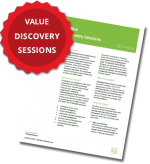What CIOs Must Know about Agile Development
By: Matt Angerer
In a rapidly evolving digital business environment, CIOs are under increased pressure. Yet, at the same time, they are finding that traditional development methods are not suitable for modern demands. This perfect storm of increasing pressure from shareholders and underperforming waterfall-based development is forcing CIOs to re-evaluate how they deliver software. More and more, companies are opting to leverage agile development to boost project speed.
When handled well, agile development can become a key part of the suite of methods used by CIOs to meet increasing business demands. The alternate is also true. When agile development is not performed well, it can result in far more issues than it solves. Picking the right tools to use for the job like HP Agile Manager can pay huge dividends in the long-term, but having the right mindset of what Agile truly means to your organization is even more important. The business technology tools you pick will only compliment your philosophy towards Agile development.
Instead of pitching you on the features and functionality of HP Agile Manager (our tool of choice by the way!), we want to explore some of the common mindsets that we believe a CIO should embrace towards his or her journey into Agile utopia. Let’s take a look:
Agile Is All-Encompassing
There tends to be a perception that agile refers to just one thing, but in actuality, agile development refers to a broad set of approaches in software development. At the core of those approaches is a common philosophy. If your company is just getting started with agile development, it is important to focus your approach on one method and make sure you master that before branching out to try other approaches. The common philosophy of agile development hinges on a servant leader (Scrum Master) and team concept.
Everyone Needs to Be Involved in Agile Development
It simply is not possible to leverage the many benefits of agile development if everyone is not engaged. That includes management, leaders, and users. If other key players in your business do not embrace agile, you will need to make a concerted effort to bring everyone together so that you are all on the same page.
Take Baby Steps
Yes, agile development is exciting, but it’s important to make sure you do not try to tackle too much at once. Enterprises experienced in agile development can more easily tackle larger scale projects, but when you are just started out, you need to begin slowly. It takes a number of years to develop the skills necessary to take on large-scale agile development.
Be Prepared to Commit to Ongoing Learning
Agile development is not something that you can master and simply forget about. In order to continue moving ahead, you must embrace continuous learning. Furthermore, learning is not the sole responsibility of a small group of programmers. Learning could mean sending your team to the ResultsPositive campus for Certified Scrum Master (CSM) training, or engaging one of our HP ExpertOne Certified Consultants to train your Scrum teams on HP Agile Manager.
Agile Extends Beyond Software Development
There is sometimes a temptation to allocate agile methodology strictly to software development. A critical element of agile is the idea of continuous delivery. When handled correctly, agile methodologies can result in the delivery of a continual stream of new software. In order to ensure a successful delivery of software, it is necessary to institute changes in operational practices. Scrum refers to these user stories as “chores.” We encourage you to embrace these “opportunities” to improve your organization’s operational processes. Have fun with it!
Don’t Neglect Other Software Development Approaches
As wonderful as agile development is, it’s important to keep in mind that not all of your development problems will be well suited to the agile framework. In fact, some of your development projects may be better suited to a more incremental or waterfall-based approach. Always keep in mind that agile is not necessarily a better approach, but it is often more adaptable to pressing development problems.
Have questions about the implementation of agile development within your organization?
Contact our ALM experts and start solving today!
Subscribe for the latest RP Blog Updates:










